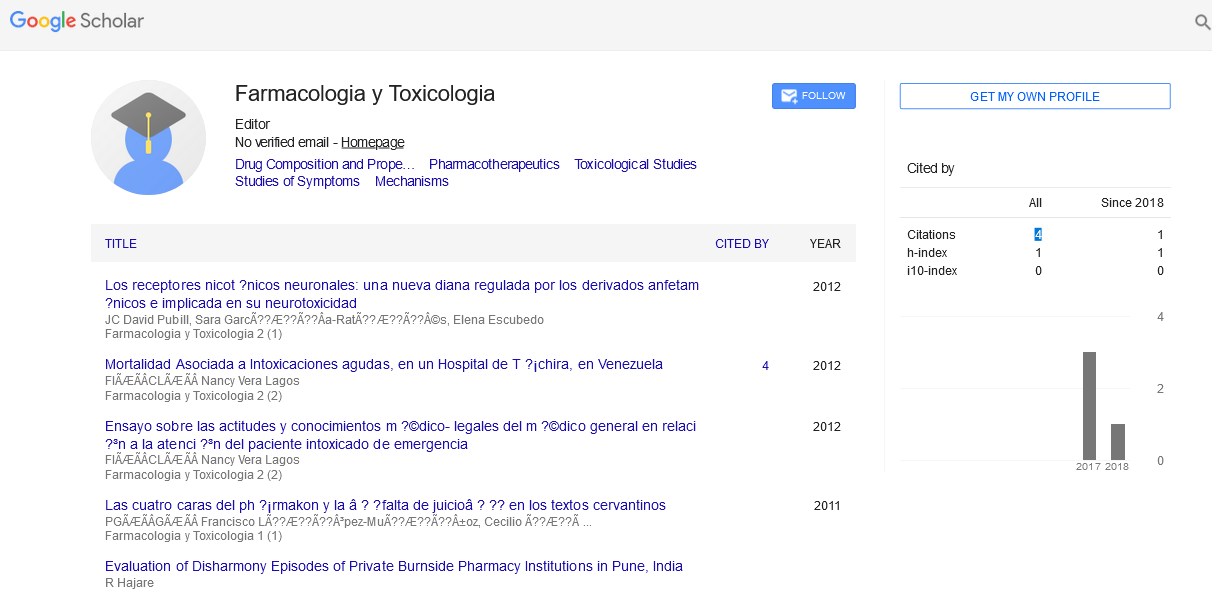Perspective - (2024) Volume 14, Issue 4
Drug Efficacy and Toxicology: Balancing Benefits and Risks
Heinrich Jurling*
Department of Toxicology, University of Tectiju, Tijuana, Mexico
*Correspondence:
Heinrich Jurling, Department of Toxicology, University of Tectiju, Tijuana,
Mexico,
Email:
Received: 02-Jul-2024, Manuscript No. IPFT-24-14975;
Editor assigned: 05-Jul-2024, Pre QC No. IPFT-24-14975 (PQ);
Reviewed: 19-Jul-2024, QC No. IPFT-24-14975;
Revised: 01-Aug-2024, Manuscript No. IPFT-24-14975 (R);
Published:
29-Aug-2024
Introduction
In the realm of medicine and pharmacology, the
development of new drugs is a complex and meticulous
process aimed at improving human health. Central to this
process is understanding drug efficacy and toxicology-two
critical aspects that determine the safety and effectiveness
of pharmaceutical interventions.
Description
Drug efficacy: Ensuring effectiveness
Drug efficacy refers to the ability of a drug to produce the
desired therapeutic effect in patients. This effectiveness is
evaluated through rigorous clinical trials that assess the drug's
ability to treat, cure or prevent a specific condition compared to
a placebo or existing treatments. Efficacy studies are designed
meticulously, often following phases from preclinical research to
post-marketing surveillance, ensuring thorough evaluation
across different populations and conditions.
Phases of efficacy testing
Preclinical studies: Before human trials, drugs undergo
extensive testing in laboratories and on animals to assess their
biological activity, toxicity levels and potential efficacy. These
studies provide initial insights into safety and effectiveness.
Clinical trials: Human trials are conducted in phases to
progressively evaluate safety and efficacy. Phase I focuses on
safety in healthy volunteers, Phase II expands to a small group of
patients to test efficacy and Phase III involves large-scale trials to
confirm effectiveness, monitor side effects and compare against
existing treatments or placebos.
Post-marketing surveillance: Even after approval, drugs are
continuously monitored for long-term safety and efficacy
through post-marketing surveillance studies. This phase helps
identify rare side effects or interactions that may not have been
apparent in earlier phases.
Assessing drug toxicology: Mitigating risks
While efficacy determines a drug's therapeutic value,
toxicology assesses its potential harm or toxicity. Every drug
carries risks of adverse effects, ranging from mild discomfort to severe health complications or death. Understanding and
mitigating these risks is crucial in drug development and clinical
use.
Types of toxicological studies
Acute toxicity: Determines the adverse effects of a single
exposure to a drug over a short period, typically within 24 hours.
This study helps establish safe starting doses for clinical trials.
Subacute and chronic toxicity: Assesses adverse effects from
repeated exposure over weeks to months, simulating prolonged
human use. This phase identifies cumulative effects and
potential long-term risks.
Genotoxicity and carcinogenicity: Evaluates a drug's ability to
damage genetic material (genotoxicity) or cause cancer
(carcinogenicity), critical in determining safety for chronic
therapies.
Reproductive and developmental toxicity: Studies potential
harm to reproduction or fetal development, ensuring drugs are
safe for use in pregnant women or reproductive-age adults.
Balancing bene its and risks
The process of drug development is inherently a balancing act
between therapeutic benefits and potential risks. Regulatory
agencies such as the FDA (Food and Drug Administration) in the
United States or the EMA (European Medicines Agency) in
Europe play pivotal roles in evaluating this balance. They review
comprehensive data on efficacy and toxicology before approving
drugs for market use.
Risk management strategies
Risk assessment and communication: Clear communication
of potential risks to healthcare providers and patients ensures
informed decision-making.
Risk minimization: Implementing strategies such as dose
adjustments, patient monitoring programs or restricted
distribution channels can mitigate risks without compromising
therapeutic benefits.
Post-market surveillance: Continued monitoring of drugs
post-approval helps detect rare adverse events and ensures
ongoing assessment of benefit-risk profiles.
Case study: Balancing act of drug approval
Consider the case of statins, widely prescribed for lowering
cholesterol. These drugs underwent rigorous efficacy trials
demonstrating significant reductions in cardiovascular risk.
However, concerns over liver toxicity emerged, leading to
stringent monitoring protocols and recommendations for regular
liver function tests during treatment.
Future Directions: Innovations in Drug Development
Advancements in pharmacogenomics, artificial intelligence
and personalized medicine promise to revolutionize drug
development. Pharmacogenomic testing, for instance, identifies
genetic variations affecting drug metabolism, guiding
personalized dosing for efficacy and safety.
Balancing benefits and risks
The ultimate goal of drug efficacy and toxicology assessments
is to strike a balance between therapeutic benefits and potential
risks:
Risk-benefit ratio: Evaluates whether the benefits of
treatment outweigh the risks.
Risk management: Involves strategies to minimize risks while
maximizing therapeutic effects.
Regulatory oversight
Regulatory bodies like the FDA (Food and Drug
Administration) in the United States and the EMA (European
Medicines Agency) in Europe play crucial roles in drug approval
processes. They meticulously review efficacy and toxicology data
before granting approval for market release. This oversight
ensures that drugs meet stringent safety and efficacy standards
before reaching patients.
Conclusion
Drug efficacy and toxicology are foundational pillars of
pharmaceutical science, ensuring that new treatments offer
meaningful benefits while minimizing potential harm. Through
rigorous testing, vigilant monitoring and ongoing research, the
field continues to evolve, striving for safer and more effective
therapies. As we navigate the complexities of drug development,
understanding this delicate balance remains essential to
advancing healthcare and improving patient outcomes.
Citation: Jurling H (2024) Drug Efficacy and Toxicology: Balancing Benefits and Risks. Farmacologia Toxicologia, Vol.14 No.4: 038





